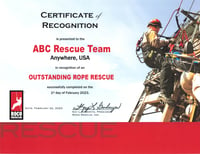 Jackson, Mississippi is a burgeoning metro area with over 600,000 residents. Interstate highways busily crisscross the city. In the early evening of April 30, 2024, emergency responders found themselves planning how to recover the body of a man that had been missing for a month.
Jackson, Mississippi is a burgeoning metro area with over 600,000 residents. Interstate highways busily crisscross the city. In the early evening of April 30, 2024, emergency responders found themselves planning how to recover the body of a man that had been missing for a month.
An angler had discovered the body and called 911. Local law enforcement confirmed the location of the body and the Hinds County Department of Emergency Management called for resources. Raymond Fire Protection District answered the call. As the Technical Rescue arm of the multi-agency response and also knowing that the area was filled with levees and flood control zones, Raymond firefighters geared up with ropes and a SKED stretcher system.
On scene personnel had originally determined that boat access would be the best approach, but the location of the body along the 40’ rocky slope quickly changed to a ground-based recovery.
Raymond firefighters and other responders moved through three quarters of a mile of brush, loose scree, and at times, knee deep sand to arrive on the levee above the body. With darkness now upon them, the eight technical rescuers began planning the recovery operation.
Because they were in the middle of the often-flooded levee, rescuers moved forty yards to the west of the Pearl River to an elevated billboard advertising to the thousands of cars passing by every day on Interstate 20. An anchor was established and extended over 100-feet to the top of the levee.
 Three rescuers scrambled down the slope to assist local law enforcement. The victim was placed in a body bag and securely packed in the SKED stretcher. Meanwhile, topside rescuers used the extended anchor to establish a haul system using a Petzl Maestro and a newly acquired CMC Capto in a 3:1 Z-Rig configuration.
Three rescuers scrambled down the slope to assist local law enforcement. The victim was placed in a body bag and securely packed in the SKED stretcher. Meanwhile, topside rescuers used the extended anchor to establish a haul system using a Petzl Maestro and a newly acquired CMC Capto in a 3:1 Z-Rig configuration.
Four litter attendants lifted the man, and the haul began. Heavy brush and knee-deep sand proved challenging, but the team soon reached the top of the levee. While rescuers were coming up the slope, personnel from Hind County EMS, Jackson Fire Department and local law enforcement had made access to the area traveling in a side-by-side. The victim was loaded and driven to the roadway to be transferred to the coroner. All told, emergency responders spent nearly four hours moving the body.
 So often, the outcome of our rescue response is predetermined. Our actions provide closure rather than the excitement of a rescue. However, we can take solace in knowing that the professionalism and preparedness of local responders gave a local family the opportunity to say goodbye.
So often, the outcome of our rescue response is predetermined. Our actions provide closure rather than the excitement of a rescue. However, we can take solace in knowing that the professionalism and preparedness of local responders gave a local family the opportunity to say goodbye.
Roco Rescue is honored to recognize Raymond Fire Department, Hinds County Department of Emergency Management and other Jackson, Mississippi, responders that espouse the definition of quiet professional.








 Half-face respirators
Half-face respirators Self-contained breathing Apparatus (SCBAs)
Self-contained breathing Apparatus (SCBAs) Supplied Air Respirators (SARs)
Supplied Air Respirators (SARs)
 Fall Arrest vs. Fall Restraint:
Fall Arrest vs. Fall Restraint: Choosing Between Fall Arrest and Fall Restraint:
Choosing Between Fall Arrest and Fall Restraint:





